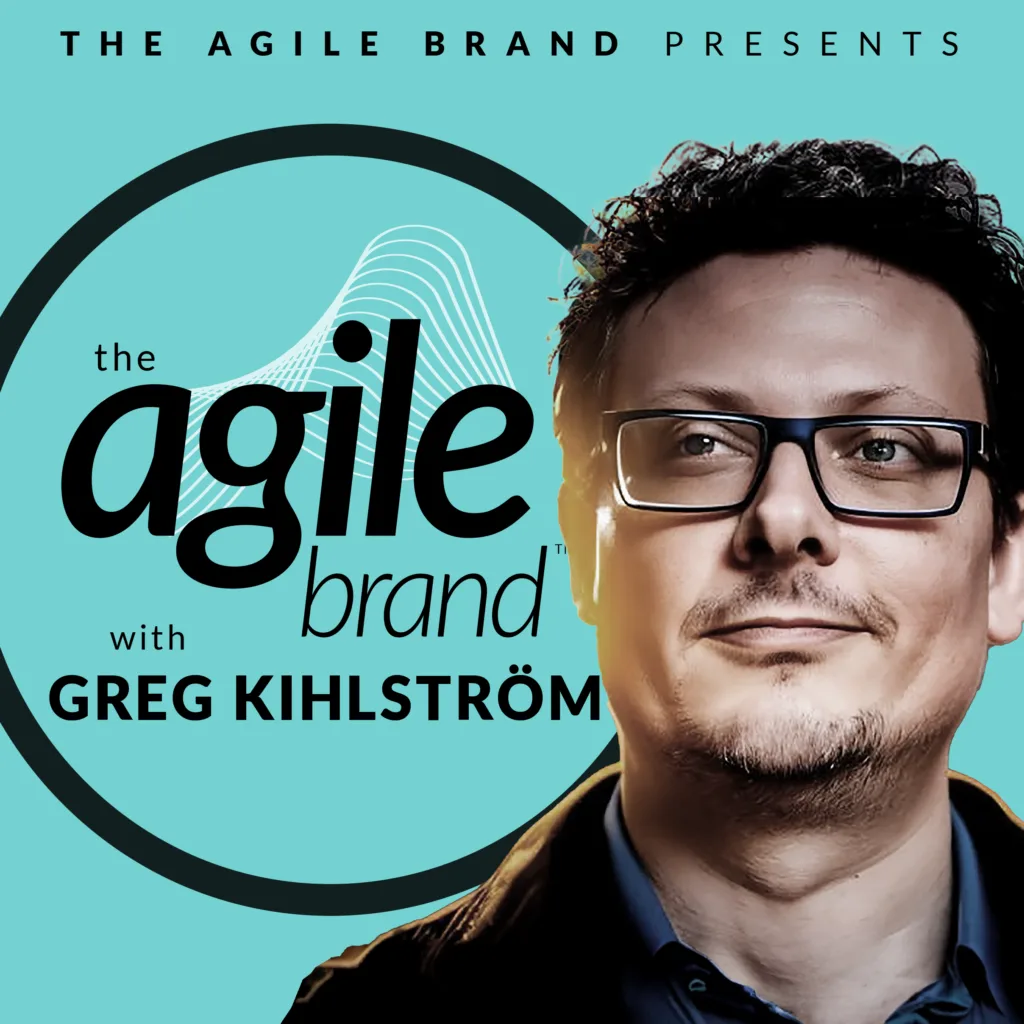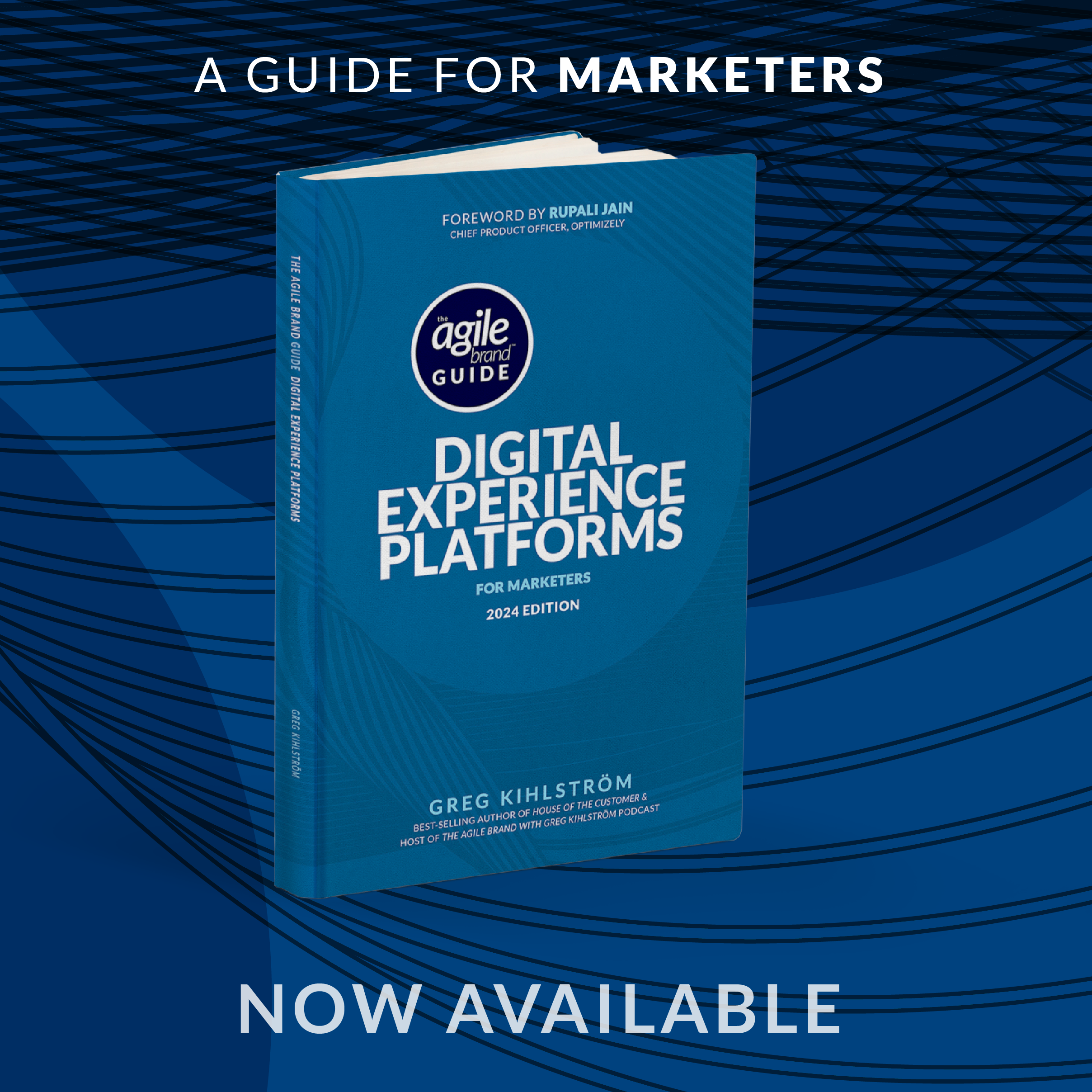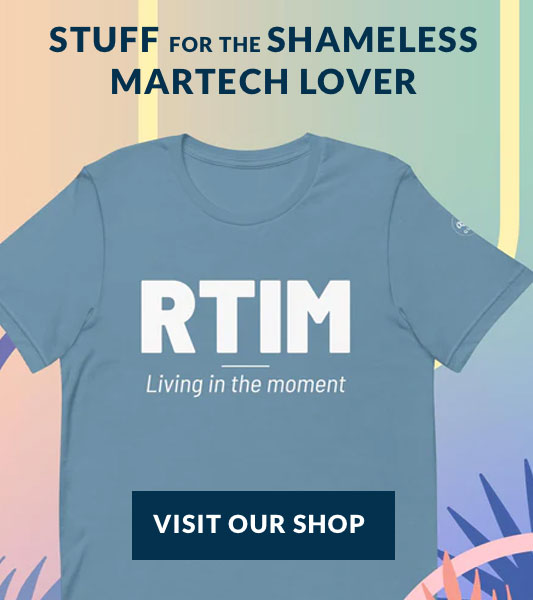We are here at eTail Palm Springs and seeing and hearing the latest and greatest in e-commerce and retail.
When brand trust is everything, how do companies ensure they aren’t just talking about values but actually demonstrating them in ways that resonate with increasingly savvy and socially conscious consumers?
Joining us today is Aman Advani, CEO of Ministry of Supply.
Ministry of Supply is known for revolutionizing performance professional wear by blending technology, sustainability, and comfort into their apparel and today we’re going to talk about how brands engage with socially conscious consumers and bridging the gap between in-store and digital experiences to create seamless, omnichannel shopping journeys.
Resources
eTail Palm Springs: https://etailwest.wbresearch.com/
Connect with Greg on LinkedIn: https://www.linkedin.com/in/gregkihlstrom
Listen to The Agile Brand without the ads. Learn more here: https://bit.ly/3ymf7hd
Don’t miss a thing: get the latest episodes, sign up for our newsletter and more: https://www.theagilebrand.show
Check out The Agile Brand Guide website with articles, insights, and Martechipedia, the wiki for marketing technology: https://www.agilebrandguide.com
The Agile Brand podcast is brought to you by TEKsystems. Learn more here: https://www.teksystems.com/versionnextnow
The Agile Brand is produced by Missing Link—a Latina-owned strategy-driven, creatively fueled production co-op. From ideation to creation, they craft human connections through intelligent, engaging and informative content. https://www.missinglink.company
Transcript
Greg Kihlstrom:
Welcome to season seven of the Agile Brand, where we discuss the trends and topics marketing leaders need to know. Stay curious, stay agile, and join the top enterprise brands and martech platforms as we explore marketing technology, AI, e-commerce, and whatever’s next for the omni-channel customer experience. Together, we’ll discover what it takes to create an agile brand built for today and tomorrow, and built for customers, employees, and continued business growth. I’m your host, Greg Kihlstrom, advising Fortune 1000 brands on Martech, AI, and marketing operations. The Agile Brand Podcast is brought to you by TEKsystems, an industry leader in full stack technology services, talent services, and real world application. For more information, go to teksystems.com. To make sure you always get the latest episodes, please hit subscribe on the app you listen to podcasts on and leave us a rating so others can find us as well. And now onto the show. We are here at eTail Palm Springs and seeing and hearing the latest and greatest in e-commerce and retail. When brand trust is everything, how do companies ensure that they aren’t just talking about values, but actually demonstrating them in ways that resonate with increasingly savvy and socially conscious consumers? Joining us today is Aman Advani, CEO of Ministry of Supply. Ministry of Supply is known for revolutionizing performance professional wear by blending technology, sustainability, and comfort into their apparel. And today we’re going to talk about how brands engage with socially conscious consumers and bridging the gap between in-store and digital experiences to create seamless, omni-channel shopping journeys. Aman, welcome to the show. Thanks so much for having me. I appreciate being here. Yeah, looking forward to talking about it. It’s always great to be in person here at these shows. Before we dive into, got a few things to talk about. Why don’t you give us a little more background on yourself and Ministry of Supply?
Aman Advani: Yeah, that sounds great. So again, my name is Aman, co-founder and CEO of Ministry of Supply. We were born in Boston just over a decade ago now. My partner and I were classmates and I was in business school, he was undergrad, so not quite classmates. We both came to each other with the same idea. I was coming from a consulting world where I hated getting on a flight every Monday morning, off a plane every Thursday night. He was graduating undergrad, getting ready to dress up for the real world. And so we both actually had been cutting and sewing our own clothes. I had been cutting out the soles of my dress socks and sewing in my Nike cushy soles. so that I would be kind of walking on Nike Air during my work day. And so when we came together and said, we’re the only two kids at MIT focused on fashion, let’s become partners. 12 years later, the premise hasn’t changed. How do we take the comfort and technology behind your favorite Nike gear and apply it or create it or invent it to apply it to your least favorite dress clothes? And that’s really the central premise of Ministry of Supply and has been for a decade plus now. Nice, nice. I’m going to have to get some of those socks. They’ve improved since then.
Greg Kihlstrom: Nice, nice. That’s awesome. So, yeah, we’re going to talk about a few things here. But, you know, as I mentioned at the top of the show, I want to first start talking about building brand trust with a savvy and socially conscious consumer. Today’s consumers expect brands to be transparent about their values, sourcing, sustainability efforts. What do you think are the biggest challenges that brands face in proving authenticity in these things?
Aman Advani: Yeah, so I mean, the number one thing that comes to mind when I hear authenticity is human, right? An authentic brand has to be a human brand. A few years ago, I had a mentor ask me, kind of, when’s the last time you spoke to a customer? Maybe here and there, right in the store, I’d run into a customer. It ended up being a really pivotal moment where I made a commitment to myself and to our team that I would talk to five customers a day until I felt like it wasn’t necessary. And now here three years later, it’s still necessary. And so I spend every single morning from 8.30 to 8.45 answering five customer emails that have been routed to my inbox and have found that over three years of doing that, there’s an army of people out there on social media and forums and Slack channels that have a one-to-one relationship with our brand through me or through other members of our team, through our customer service team, through our stores. that feels some direct human connection that we’ve accumulated through hours and hours and hours of time invested. And so I think the answer to authenticity has to come back to time and humanity.
Greg Kihlstrom: Nice. I really like that because, I mean, A, I’ve been a customer that feels like, wow, I don’t feel like anyone’s listening to me. I’ve also, you know, there’s a lot, I think there’s a few good stories at least of companies that make sure that all of their employees kind of go through and answer those emails. But to hear the CEO of a company, you taking your time to do that every day, like that’s, I think that’s really powerful. So I guess, you know, I wonder, I’m sure you get a lot of, the data as well, the quantitative stuff. How does your view of the overall view of the customer shaped by both of those working together?
Aman Advani: Yeah. Interestingly, what’s emerged, I’d say organically from talking to a thousand customers a year, is I can create a lot of data points. And a lot of the leaders on our team are also doing the same thing. My co-founder does a video chat with a customer every single day. And he’s getting a different type of insight because he’s doing shopping, shop-alongs, right? So every single day he engages with one customer on a video. And what we can do through hundreds and now thousands of data points is we create little theories and hypotheses. What ends up happening is the data no longer serves to create the origin of the story. It becomes the confirmation or denial of our theories. Now, these fresh, new, exciting ideas come from directly customer pain points and conversations. They get confirmed or denied through data, and then they get to market really quickly, whether that be a product, an initiative, a user experience tweak, things like this that can come to life from concept to reality within a week in many cases.
Greg Kihlstrom: Yeah, so this is way off topic but I’m going to go with this because I’m kind of interested in this because I think there’s that bias of, you know, the anecdotal evidence, right? So it’s like that, you know, that’s one thing that kind of comes to mind of like, OK, you have a few conversations and then you have this like anchor bias or whatever the, you know, there’s hundreds of biases or whatever. So you’re kind of solving for that in mixing, you know, the quantitative with the, you know, we’ll call it qualitative as well, but you’re doing it in volume so that it’s not really an anecdotal like, oh, well, this one person said they didn’t like the color blue or whatever. Right.
Aman Advani: Absolutely. Yeah. And I will say, like, it is also a ticket to bias if you’re not careful. Yeah. Where sometimes we would phrase these emails and only send, you know, our first cohort when we started doing this, which was wrong, was we only sent it to our mega customers, right? People who had spent several thousand dollars in the last few months at Ministry of Supply, we’d say, we want to hear from you. And wonderful, it was really helpful to hear from them. but it was not an unbiased viewpoint, right? These are people who already love us and want us to double down on certain things we’re doing well. How do we start to attack the people who almost bought from us but didn’t for one small reason? I want to know what that is and make a decision as to whether or not we fix it or double down on our stance, right? I think getting to the point where you have those unbiased insights and you’re able to get a really wide variety of Whales, prospects, win backs, all into your conversations will create a truly holistic view of what your customer is thinking and why.
Greg Kihlstrom: Yeah, yeah. I think that idea of listening and it’s the feedback loop. I mean, there’s lots of ways to look at authenticity, but I think I just think of myself as a customer. It’s like, okay, I put something out there. I take the time, just like you’re taking time to talk with people, other people in your company are taking the time to talk with people. Someone, a customer, takes time out of their day to give feedback, and then it’s just like, okay, nothing ever, you know, it’s like.
Aman Advani: Where did it go? Yeah, yeah. The amount of responses I get to these emails saying like, I doubt there’s a real human here, and then three minutes later, they get a fully custom response with my cell phone number in it, and realize like, no, we’re absolutely listening. We only exist because of these emails, right? Because people tell us what their real deep problem statements are in a candid, safe place. We’re able to fix them.
Greg Kihlstrom: So another thing I want to talk about with you is, so, you know, a lot of your business is online, but you do have physical retail store as well. And talk about kind of bridging the in-store and the online experiences. Certainly, you know, Omnichannel is mentioned a lot these days and certainly a lot on the show as well. What does a great omnichannel experience look like today?
Aman Advani: Yeah. A few years ago, we made this unintentionally pivotal decision and what that meant for us, where we, just by the nature of really strong leaders on our team, decided to combine our customer service and our retail and our wholesale teams all under one leader. And it was because that leader was just particularly good at handling all three of them. Now, what ended up unintentionally happening is that the three teams, which are all relatively small, ended up becoming effectively one team. They’re all sitting in different locations. One group is sitting in the Philippines. That’s our offshore customer service. One group is sitting in retail or pop-up stores. And one group is sitting in our office, right? And they’re handling wholesale. But now, by allowing those three teams to feel like one, they’re obsessed with this kind of nurture process. There’s tons of handoffs every single day between a customer who came in and store, then bought something on Nordstrom and then returned it to our website because that’s where they wanted to and they can touch all three of our kind of quote unquote channels, they can come and touch with one seamless experience. That name now has a thread and has a seamless experience across all three. And so by unintentionally combining all of this into what we just call broadly service, Our customer service teams, retail crew, and our wholesale crew all act as one unified force that is obsessed with that joy of the customer. And so I would say the number one thing we’ve done there is avoided the concept of Omnichannel by really not having a clear separation anyway.
Greg Kihlstrom: Yeah, so that’s interesting because I think a lot of companies are looking at it from the platform, you know, it’s like people process platform, right? So like, a lot of companies are looking at it from the platform perspective. And then I, you know, in my consulting work, I run into the, the process and the people part of like, okay, now, these people’s what, even if they sit in the same office, they’re still are not used to working with each other. So it sounds like Yeah, I mean, I’m sure there’s technology involved as well. But it sounds like you, Did you approach it from a people and process part first, then? Is that kind of, yeah.
Aman Advani: Exactly, but I think we have probably to a fault prioritized leaders’ passions over logical decisions, right? And we’ve been also lucky to have fairly long tenures at our company, so investing in those leaders’ passions has tended to pay out. Rarely do we make an org chart decision and the leader leaves, which would kind of defeat the purpose. But often, we’ll make these kind of sometimes micro decisions on two people being on the same team, two groups being in the same function based upon a leader’s skill set. I think it’s probably not in the playbook of perfect, but it’s worked well for us in investing further in those leaders and their joy leads to a better product on the other end.
Greg Kihlstrom: Well, I mean, I do think there’s a lot of companies that are struggling with how do they do that. You know, again, you have these siloed teams and org structures and everything like that, and how do you, you know, there’s lots of, there’s federated models, there’s putting everybody under one umbrella, there’s lots of ways of doing it, but it’s interesting to hear how that’s worked. I guess to talk a little bit about the technology, though, you know, looking at some of the tools that you’ve used, to enhance in-store shopping, so like QR codes, mobile apps, things like that. How do you use technology to enhance that in-store?
Aman Advani: Yeah, we could certainly go through that playbook, and it’s probably a lot of the things you’ve already heard before. But what I’d actually kind of point to is that experience of kind of crossing channels seamlessly, I continue to double down on the idea that it happens behind the customer, not in front of them. What I mean by that is putting all of these folks on a single Slack channel allows us to communicate about that customer in a positive way without that customer having to be bothered by it. They don’t have to worry about whether or not they buy the pants in-store and the suit jacket gets shipped online. Why do they care? They shouldn’t. They shouldn’t need to know that those are two separate transactions and they’re two separate roll-ups, right? Similarly, we have an email address, concierge at ministrysupply.com, that contains the top two leaders of every channel. And so if somebody emails in, somebody on our team will be able to answer that, and relatively rapidly. It’s coming directly to their inbox. It’s not going to a Zendesk queue, right? That email is going to all of the primary leaders. And so they’re answering, they’re talking to customers every single day, just like I am. And so I’d say that the technology I’m referring to, Slack and email, they’ve been around for a while, are the behind-the-scenes tools we use to create that seamlessness rather than the traditional QR code. There are wonderful front solutions here, but I think you’ve heard them before. I’ll focus my answer here on what happens behind the customer’s back.
Greg Kihlstrom: So it’s more, it’s almost philosophy, right? Structural. Yeah.
Aman Advani: Absolutely.
Greg Kihlstrom: Yeah. Yeah. Yeah. Love it. You know, there’s been a lot of focus on like inventory, like supply chain stuff over the, over the last few years with, with retail. How do you look at, you know, inventory management and how does like data and analytics play into that?
Aman Advani: Yeah. Where I’ve talked a lot about the qualitative relationship with the customer and helping us to predict and drive all of our time into making the best product, we are deeply and heavily relying upon software solutions to power our supply chain. We use Crest for inventory management. We use bProduct for product development. We have a wonderful suite of tools that we use to make sure that the product is correct when it gets to the customer’s doorstep in the right place at the right time and the right volume. Fundamentally, we’ve realized that inventory turns are the only metric of success when it comes to a supply chain. We talk about IOH. We talk about stock-in levels. We talk about AOV and conversion rate being impacted by all this. But, really, it ultimately comes back to high margins and fast turns cure all. We’ve heard this saying before and it’s absolutely true. We focus, I’d say, more on the speed of turns. In fact, we’ll take a worse price for a smaller batch that we can iterate faster. We’ve realized over and over and over, being agile in your supply chain is a superpower.
Greg Kihlstrom: Well, Aman, thanks so much for joining today. One last question before we wrap up here, I’d like to ask everybody on the show, what do you do to stay agile in your role and how do you find a way to do it consistently?
Aman Advani: Yeah, so I often will end up, you know, we’re here at eTail and I’ll end up coming to places like this to make sure that while I’m deeply locked in my Ministry of Supply bubble, 95% of the day that I will force myself at least once a month to engage with other leaders, other technology, other brands. And so I’d say constantly pushing myself out of my normal comfort zone into grabbing a coffee with two founders on Friday that are in my space or chatting with you. Hearing your podcast allows me to have this constant exposure to what’s happening and whether or not I want to participate.












